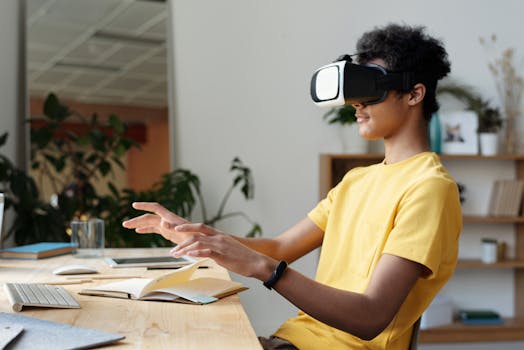What is immersive learning experiences?

What is Immersive Learning Experiences?
In today’s fast-paced world, traditional learning methods can often feel stale and uninspiring. Enter immersive learning experiences, a transformative approach designed to engage learners in a way that captivates their interest and enhances understanding. This method utilizes technology and interactive elements to create a multi-sensory educational environment. As these methods gain traction in both educational settings and personal development, it’s essential to understand what they entail and how they can benefit us.
Understanding Immersive Learning Experiences
Immersive learning experiences go beyond the conventional classroom setup. Instead of passively absorbing information, learners actively engage with content. This interaction promotes a deeper understanding of complex concepts and helps to retain information.
Definition and Characteristics
At its core, immersive learning involves creating an environment where learners can explore and interact with information in a way that mimics real-life situations. Characteristics of immersive learning include:
- Interactivity: Learners don’t just observe; they participate actively.
- Engagement: The experiences are designed to be captivating, keeping learners focused.
- Emotional connection: By involving learners on multiple sensory levels, these experiences foster stronger emotional ties to the material.
This learning style contrasts sharply with traditional education, where the emphasis is often on rote memorization and passive listening.
Types of Immersive Learning Experiences
Several formats fall under the umbrella of immersive learning. Here are a few notable types:
-
Virtual Reality (VR): Through VR headsets, learners can enter entirely new environments, allowing them to practice skills or explore scenarios that would be impossible in the real world. Companies like STRIVR utilize VR for employee training, simulating real-world situations in a safe space.
-
Augmented Reality (AR): Unlike VR, which creates a wholly virtual environment, AR overlays digital information onto the real world. This technology can be used for everything from interactive textbooks to guided tours.
-
Simulations: Simulations allow learners to practice skills in a controlled environment. This method is prevalent in fields such as aviation and healthcare, where hands-on practice is critical.
-
Role-Playing: This technique involves learners taking on roles within a scenario, enabling them to experience situations from different perspectives.
Each of these immersive experiences offers unique advantages, catering to various learning styles and preferences.
Benefits of Immersive Learning Experiences
The advantages of immersive learning extend beyond mere engagement. Here’s a closer look at why they are becoming increasingly popular.
Enhanced Engagement and Retention
One of the most significant benefits of immersive learning experiences is the increased level of engagement they provide. Learners are more likely to remember information when they are actively involved in the learning process. Research shows that our brains retain information better when we experience it firsthand. Interactive environments, such as those described by the Center for Engaged Learning, help create lasting memories by embedding knowledge in contexts that matter.
Real-World Application
Immersive learning experiences also allow learners to apply their knowledge in real-world scenarios. This practical application builds confidence and competence. For example, a medical student using VR to practice surgery can hone their skills in a risk-free environment before entering the operating room. By bridging the gap between theory and practice, immersive learning fosters a deeper understanding of complex subjects.
Implementing Immersive Learning Experiences
Incorporating immersive learning into your educational or training programs can be straightforward with the right tools and strategies.
Tools and Technologies
To create immersive learning experiences, a variety of tools and technologies can be employed:
- VR Headsets: Devices like Oculus Rift or HTC Vive offer immersive visual experiences.
- AR Applications: Mobile apps can provide AR experiences that engage learners in their environment.
- Simulation Software: Programs simulate real-world situations for hands-on practice.
Each tool serves a unique purpose and can be tailored to suit specific learning objectives.
Best Practices for Implementation
To successfully integrate immersive learning experiences, consider these best practices:
-
Set Clear Learning Objectives: Know what you want to achieve with immersive learning. Define the skills or knowledge areas you want to focus on.
-
Engage Multiple Senses: Use sights, sounds, and even touch to create a rich learning environment.
-
Allow for Exploration: Encourage learners to interact and explore the content without fear of making mistakes.
-
Gather Feedback: Use surveys or discussions to collect learner feedback, helping you refine future immersive experiences.
By following these guidelines, you can create immersive learning experiences that maximize engagement and effectiveness.
Future of Immersive Learning Experiences
As technology continues to advance, the potential for immersive learning experiences grows tremendously.
Advancements in Technology
Emerging technologies like artificial intelligence and machine learning will further enhance the capabilities of immersive learning. Tailored content that adapts to learners’ specific needs and progress will become more common. This personalized approach will make the learning experience even more impactful.
Broader Applications in Various Fields
The application of immersive learning experiences is expanding across various sectors. For instance, businesses are using immersive training to prepare employees for customer interactions, while the healthcare industry is employing these techniques for surgical training. As noted in Talespin’s insights, immersive learning is set to redefine training methodologies across numerous disciplines.
Conclusion
Immersive learning experiences represent a significant shift in how we approach education and training. By fostering engagement, enhancing retention, and allowing real-world application, these experiences offer powerful opportunities for personal and professional development. As technology continues to advance, the future of immersive learning looks promising, opening the door for innovative applications in various fields. Whether you’re a student, educator, or professional, embracing immersive learning experiences can pave the way for deeper understanding and enhanced skills.